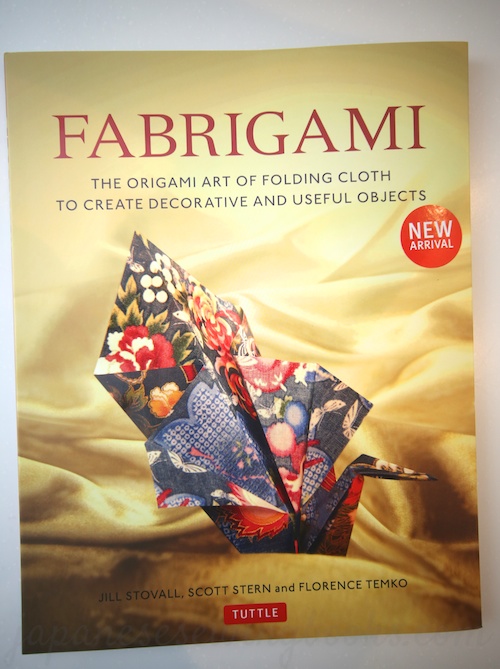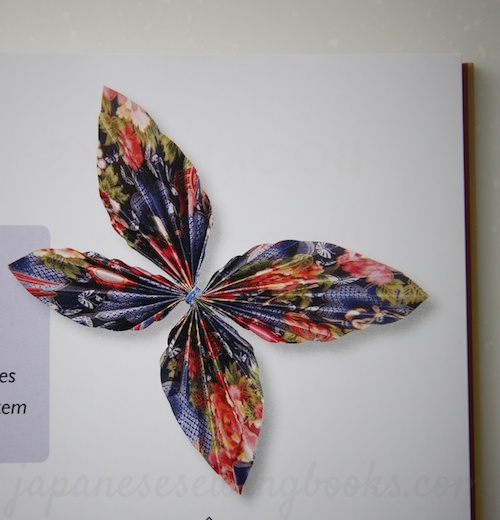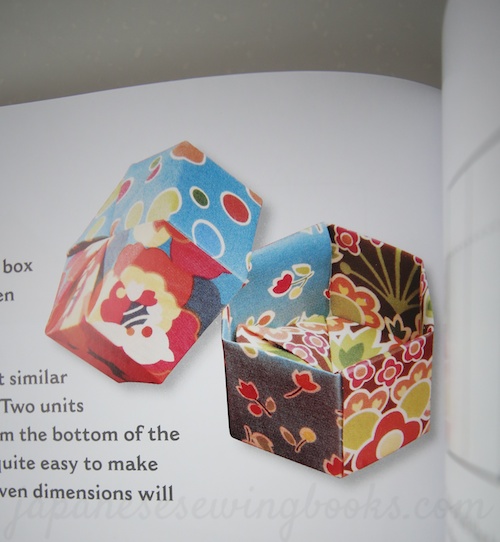Another sneak peek review of a soon to be published book from Tuttle. It’s not a sewing book, but it combines the use of pretty Japanese fabrics and the traditional art of Origami and the book is aptly titled – Fabrigami.
The only Origami I can fold without having to refer to a book is the paper crane. It was not till this year, when my 9 yr old brought home the Origami craze from school, that I started buying books on Origami for her. One of the best books I have found for teaching Origami to kids was found in a Japanese bookstore on my Osaka trip. The book 大人気!!親子で遊べる5‐7才のたのしい!おりがみ was targeted at 5-7 year olds (there is a younger 3-5 yrs version) and entirely in Japanese. But the diagrams were easy enough to follow and she has made lots of stuff from it!
I have also bought other books like Origami Boxes but she was not so keen on that and I realized why. The diagrams were not so easy to follow. So when I received this book from Tuttle she went “Wow”! I think it was not just “Wow” at the projects, but also “Wow” at the use of fabric. The difference between this book and the traditional origami book is that the projects use stiffened fabric instead of paper. It is definitely more long lasting than using paper, and a great idea for co-ordinating your home decor!
Many of the fabrics used in the projects are traditional Japanese prints, and if you need a source, you can check out Lia San’s Atelier. She sells the most beautiful Japanese fabrics that will be perfect for these projects.
Lots of projects to be made. The projects are in varying levels of difficulties so no worries if you are just a beginner.
The book begins by teaching you how to prepare your fabrics for fabrigami, followed by a section on basic folding techniques. The diagrams are pretty good! The above is just an excerpt of the basic techniques page where they show you the common steps used in most of the projects.
Now let’s look at some of the projects.
A decorative butterfly (I can imagine multiples of this in various sizes, in co-ordinating fabric, on the wall of a baby’s nursery)
A very easy to make but intricate looking bookmark.
A triangular box for storing little bits of jewellery?
Another pretty but very practical storage box.
A little Kimono on a greeting card. You can use paper to make this of course, but using fabric makes it look even more like the real thing doesn’t it?
This is very interesting. It’s called a love knot and you can hide messages inside it.
Napkin rings
and even a Turkey!
A magic wand.
A very simple but stylish looking Christmas card.
Earrings!
Bottle wrapper
Business card holder
Bird of Peace
As for the instructions, here’s a sample of the diagrams included for each project.
and here’s the back cover.
Title : Fabrigami
Authors : Jill Stovall, Scott Stern and Florence Temko
ISBN : 978-4-8053-1256-8
Publisher : Tuttle Publishing
I hope you like today’s craft book review despite the fact that it’s not about sewing. But it is a great idea for using fabric scraps. Something that I have lots of and I never know what to do with them. Will be back end of the week with a translation request on types of interfacing. See you soon!
























3 Comments
Isn’t that neat! My 9yo son loves origami and would enjoy digging through my scrap bins.
Thanks for sharing 🙂 Cindy
Thanks for a great review.
Could you give us a hint about how the fabrics are prepared? I’d like to know what they use to stiffen the fabric, so I can find out if it is readily available here in Australia before buying the book. The projects do look very pretty.
Hi Clare,
You can either use a premade fabric stiffener such as Stiffy by Plaid (http://www.joann.com/plaid-stiffy-fabric-stiffener-16-oz/1419613.html). There is an alternative recipe provided in the book, that makes use of readily available items such as Elmer’s school glue. You have to follow the recipe in the book on how to use the glue to get the correct effect.